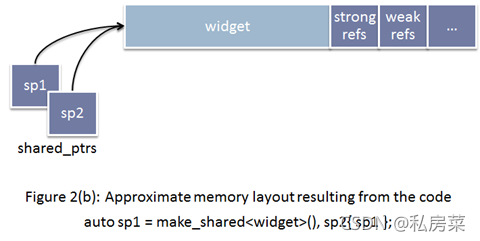写在最前。。。
0. 前言
所谓智能指针,可以从字面上理解为“智能”的指针。具体来讲,智能指针和普通指针的用法是相似的,不同之处在于,智能指针可以在适当时机自动释放分配的内存。也就是说,使用智能指针可以很好地避免“忘记释放内存而导致内存泄漏”问题出现。由此可见,C++ 也逐渐开始支持垃圾回收机制了,尽管目前支持程度还有限。
c++11 中发布了shared_ptr、unique_ptr、weak_ptr 用以资源的管理,都是定义在memory 这个头文件中。
- std::shared_ptr 允许多个shared_ptr 实例指向同一个对象,通过计数管理;
- std::unique_ptr 是独占对象;
- weak_ptr 是辅助类,是一种弱引用,指向shared_ptr 所管理的对象。
1. 源码分析
1.1 头文件
#include <memory>1.2 构造
constexpr shared_ptr() noexcept;
template<class Y> explicit shared_ptr(Y* p);
template<class Y, class D> shared_ptr(Y* p, D d);
template<class Y, class D, class A> shared_ptr(Y* p, D d, A a);
template <class D> shared_ptr(nullptr_t p, D d);
template <class D, class A> shared_ptr(nullptr_t p, D d, A a);
template<class Y> shared_ptr(const shared_ptr<Y>& r, T *p) noexcept;
shared_ptr(const shared_ptr& r) noexcept;
template<class Y> shared_ptr(const shared_ptr<Y>& r) noexcept;
shared_ptr(shared_ptr&& r) noexcept;
template<class Y> shared_ptr(shared_ptr<Y>&& r) noexcept;
template<class Y> explicit shared_ptr(const weak_ptr<Y>& r);
template<class Y> shared_ptr(auto_ptr<Y>&& r); // removed in C++17
template <class Y, class D> shared_ptr(unique_ptr<Y, D>&& r);
shared_ptr(nullptr_t) : shared_ptr() { }构造函数比较多啊,抽一个看看源码。
1.2.1 shared_ptr 的移动构造函数
template<class _Tp>
inline
shared_ptr<_Tp>::shared_ptr(shared_ptr&& __r) _NOEXCEPT
: __ptr_(__r.__ptr_),
__cntrl_(__r.__cntrl_)
{
__r.__ptr_ = 0;
__r.__cntrl_ = 0;
}
大概知道,shared_ptr 中存放一个对象的指针__ptr_ 和用以计数的__cntrl_,这两是shared_ptr 的私有成员变量:
template<class _Tp>
class shared_ptr {
typedef _Tp element_type;
private:
element_type* __ptr_;
__shared_weak_count* __cntrl_;
...
}另外,移动构造函数因为只是move,所以只是将旧的shared_ptr 转移到新的里。
1.2.2 shared_ptr 的拷贝构造函数
template<class _Tp>
inline
shared_ptr<_Tp>::shared_ptr(const shared_ptr& __r) _NOEXCEPT
: __ptr_(__r.__ptr_),
__cntrl_(__r.__cntrl_)
{
if (__cntrl_)
__cntrl_->__add_shared();
}与移动构造相同,shared_ptr 实例,需要从参数中获得__ptr_ 和 __cntrl。
但是,与移动构造函数不同的是,拷贝构造时增加对象计数的。
下面举例shared_ptr 通常的创建方式:
std::shared_ptr<int> p1; //不传入任何实参
std::shared_ptr<int> p2(nullptr); //传入空指针 nullptr
std::shared_ptr<int> p3(new int(10)); //指定指针为参数
std::shared_ptr<int> p4(p3); //或者 std::shared_ptr<int> p4 = p3;
std::shared_ptr<int> p5(std::move(p4)); //或者 std::shared_ptr<int> p5 = std::move(p4);1.3 赋值重载
shared_ptr& operator=(const shared_ptr& r) noexcept;
template<class Y> shared_ptr& operator=(const shared_ptr<Y>& r) noexcept;
shared_ptr& operator=(shared_ptr&& r) noexcept;
template<class Y> shared_ptr& operator=(shared_ptr<Y>&& r);
template<class Y> shared_ptr& operator=(auto_ptr<Y>&& r); // removed in C++17
template <class Y, class D> shared_ptr& operator=(unique_ptr<Y, D>&& r);1.4 修改的接口
void swap(shared_ptr& r) noexcept;
void reset() noexcept;
template<class Y> void reset(Y* p);
template<class Y, class D> void reset(Y* p, D d);
template<class Y, class D, class A> void reset(Y* p, D d, A a);reset 基本上是对应构造
1.5 获取
T* get() const noexcept;
T& operator*() const noexcept;
T* operator->() const noexcept;
long use_count() const noexcept;
bool unique() const noexcept;
explicit operator bool() const noexcept;
对于shared_ptr 的成员函数总结如下:
| 成员方法名 | 功 能 |
| operator=() | 重载赋值号,使得同一类型的 shared_ptr 智能指针可以相互赋值。 |
| operator*() | 重载 * 号,获取当前 shared_ptr 智能指针对象指向的数据。 |
| operator->() | 重载 -> 号,当智能指针指向的数据类型为自定义的结构体时,通过 -> 运算符可以获取其内部的指定成员。 |
| swap() | 交换 2 个相同类型 shared_ptr 智能指针的内容。 |
| reset() | 当函数没有实参时,该函数会使当前 shared_ptr 所指堆内存的引用计数减 1,同时将当前对象重置为一个空指针;当为函数传递一个新申请的堆内存时,则调用该函数的 shared_ptr 对象会获得该存储空间的所有权,并且引用计数的初始值为 1。 |
| get() | 获得 shared_ptr 对象内部包含的普通指针。 |
| use_count() | 返回同当前 shared_ptr 对象(包括它)指向相同的所有 shared_ptr 对象的数量。 |
| unique() | 判断当前 shared_ptr 对象指向的堆内存,是否不再有其它 shared_ptr 对象再指向它。 |
| operator bool() | 判断当前 shared_ptr 对象是否为空智能指针,如果是空指针,返回 false;反之,返回 true。 |
除了上面的成员函数外,C++11 标准还支持同一类型的 shared_ptr 对象,或者 shared_ptr 和 nullptr 之间,进行 ==,!=,,>= 运算。
注意:
- shared_ptr用以共享一个对象的所有权,通过计数确认自动回收;
- shared_ptr 共享的对象所有权,通过存储对象的指针,并通过get() 获取存储的对象的指针;
- 可能在多个线程中同时用不同的shared_ptr实例,而这些实例可能指向同一个对象。多线程在没有同步的情况访问同一个shared_ptr 实例,并调用其non-const 成员函数时,有可能存在数据竞争。可以使用std::atomic* 函数保护数据竞争;
2. make_shared
template<class T, class... Args>
shared_ptr<T> make_shared(Args&&... args);c++11 中针对shared_ptr 还提供了make_shared 这个外部函数,用以创建一个shared_ptr 实例。
c++ 建议尽可能使用make_shared 创建shared_ptr 实例。
下面来说明下make_shared 的优缺点。
2.1 make_shared 优点
2.1.1 效率高
shared_ptr 需要维护引用计数的信息:
- 强引用, 用来记录当前有多少个存活的 shared_ptrs 正持有该对象. 共享的对象会在最后一个强引用离开的时候销毁( 也可能释放).
- 弱引用, 用来记录当前有多少个正在观察该对象的 weak_ptrs. 当最后一个弱引用离开的时候, 共享的内部信息控制块会被销毁和释放 (共享的对象也会被释放, 如果还没有释放的话).
如果你通过使用原始的 new 表达式分配对象, 然后传递给 shared_ptr (也就是使用 shared_ptr 的构造函数) 的话, shared_ptr 的实现没有办法选择, 而只能单独的分配控制块:
auto p = new widget();
shared_ptr sp1{ p }, sp2{ sp1 };
如果选择使用 make_shared 的话, 情况就会变成下面这样:
auto sp1 = make_shared(), sp2{ sp1 };
内存分配的动作, 可以一次性完成. 这减少了内存分配的次数, 而内存分配是代价很高的操作。
2.1.2 异常安全
void F(const std::shared_ptr<Lhs>& lhs, const std::shared_ptr<Rhs>& rhs) { /* ... */ }
F(std::shared_ptr<Lhs>(new Lhs("foo")),
std::shared_ptr<Rhs>(new Rhs("bar")));C++ 是不保证参数求值顺序, 以及内部表达式的求值顺序的, 所以可能的执行顺序如下:
- new Lhs(“foo”))
- new Rhs(“bar”))
- std::shared_ptr
- std::shared_ptr
好了, 现在我们假设在第 2 步的时候, 抛出了一个异常 (比如 out of memory, 总之, Rhs 的构造函数异常了), 那么第一步申请的 Lhs 对象内存泄露了. 这个问题的核心在于, shared_ptr 没有立即获得裸指针
我们可以用如下方式来修复这个问题.
auto lhs = std::shared_ptr<Lhs>(new Lhs("foo"));
auto rhs = std::shared_ptr<Rhs>(new Rhs("bar"));
F(lhs, rhs);当然, 推荐的做法是使用 std::make_shared 来代替:
F(std::make_shared<Lhs>("foo"), std::make_shared<Rhs>("bar"));
2.2 make_shared缺点
- 构造函数是保护或私有时,无法使用 make_shared
make_shared 虽好, 但也存在一些问题, 比如, 当我想要创建的对象没有公有的构造函数时, make_shared 就无法使用了, 当然我们可以使用一些小技巧来解决这个问题, 比如这里 How do I call ::std::make_shared on a class with only protected or private constructors?
- 对象的内存可能无法及时回收
make_shared 只分配一次内存, 这看起来很好. 减少了内存分配的开销. 问题来了, weak_ptr 会保持控制块(强引用, 以及弱引用的信息)的生命周期, 而因此连带着保持了对象分配的内存, 只有最后一个 weak_ptr 离开作用域时, 内存才会被释放. 原本强引用减为 0 时就可以释放的内存, 现在变为了强引用, 若引用都减为 0 时才能释放, 意外的延迟了内存释放的时间. 这对于内存要求高的场景来说, 是一个需要注意的问题. 关于这个问题可以看这里 make_shared, almost a silver bullet
- 无法像shared_ptr 的构造那样添加一个deleter
3. 举例
#include <iostream>
#include <memory>
using namespace std;
int main()
{
//构建 2 个智能指针
std::shared_ptr<int> p1(new int(10));
std::shared_ptr<int> p2(p1);
//输出 p2 指向的数据
cout << *p2 << endl;
p1.reset();//引用计数减 1,p1为空指针
if (p1) {
cout << "p1 不为空" << endl;
}
else {
cout << "p1 为空" << endl;
}
//以上操作,并不会影响 p2
cout << *p2 << endl;
//判断当前和 p2 同指向的智能指针有多少个
cout << p2.use_count() << endl;
return 0;
}运行结果:
10
p1 为空
10
1
参考:
why make_shared ? - Bitdewy